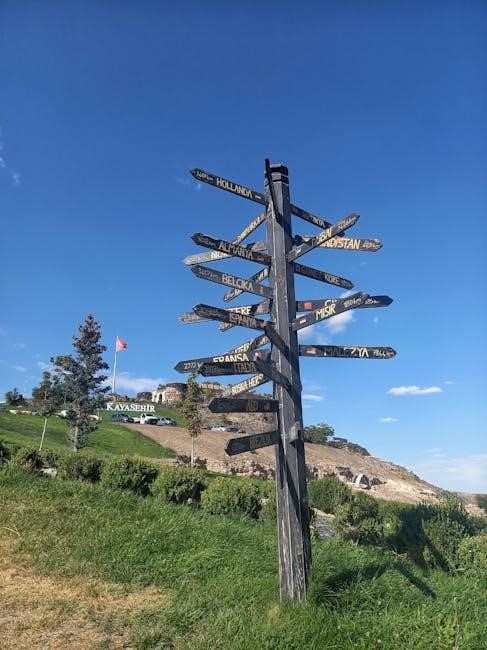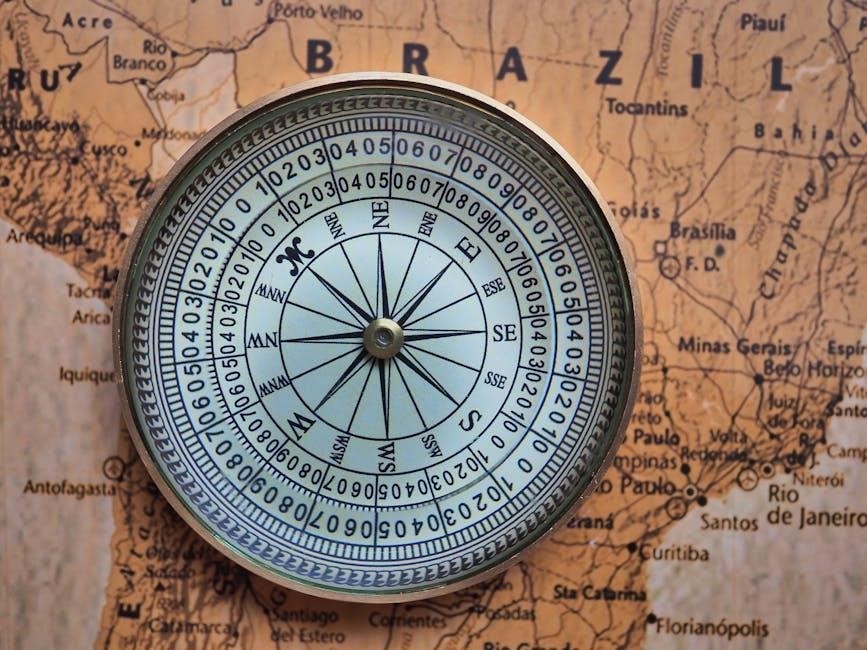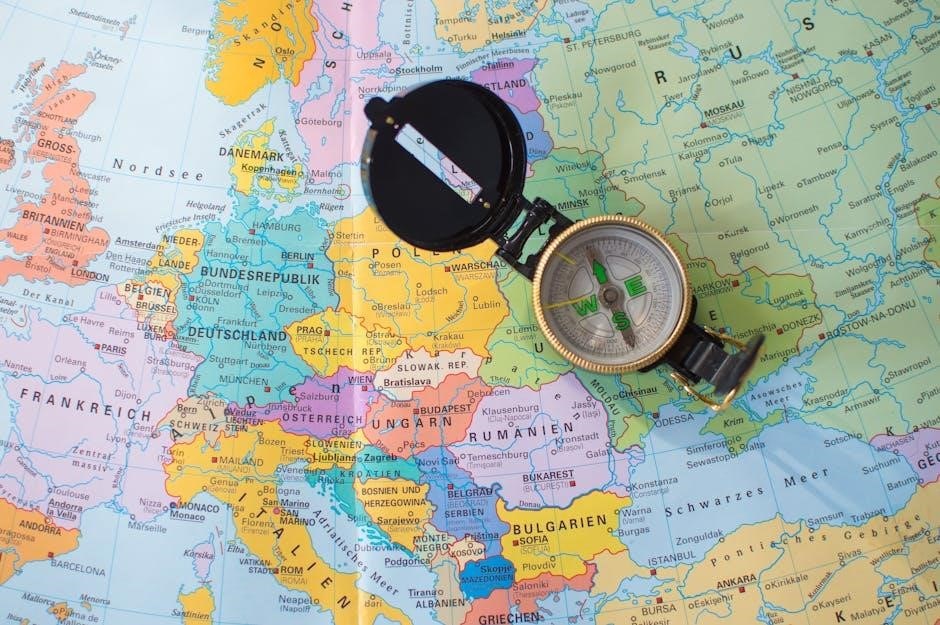
paladin pathfinder guide
The Paladin is a divine-powered martial class in Pathfinder‚ blending combat prowess with holy devotion. They serve as defenders‚ strikers‚ and supporters‚ guided by a strict code of conduct and a higher cause. Their unique abilities‚ such as Retributive Strike and divine ally‚ set them apart as versatile champions of justice.
1.1 Overview of the Paladin Class
The Paladin is a divine-powered martial class in Pathfinder‚ serving as a champion of justice‚ righteousness‚ and their chosen cause. They are a subclass of the Champion class‚ embodying the principles of their deity or ideology. Paladins are versatile warriors‚ excelling as both defenders and strikers‚ while also providing support to allies through healing and protective abilities. Their abilities are fueled by divine magic‚ granting them unique tools like Retributive Strike and divine ally. Paladins are known for their resilience‚ martial prowess‚ and ability to inspire others. They often wield two-handed weapons for maximum damage or focus on shields to protect themselves and their allies. With a strict code of conduct‚ Paladins are expected to act with honor and uphold their cause‚ making them both morally driven and tactically versatile. This class offers a blend of combat effectiveness and thematic depth‚ allowing players to craft unique builds‚ such as the Irori Paladin with monk feats‚ for a personalized holy warrior experience.
1.2 Role of the Paladin in Pathfinder
The Paladin serves as a versatile and powerful divine champion in Pathfinder‚ blending martial prowess with holy magic. Their primary role is to protect allies‚ deal significant damage‚ and uphold justice. Paladins are often seen as the party’s moral anchor‚ adhering to a strict code of conduct that defines their actions. They excel in both melee combat and support roles‚ using their divine spells to heal wounds‚ protect companions‚ and smite enemies; Their versatility makes them invaluable in various combat scenarios‚ whether leading the charge or safeguarding the party from harm. Beyond combat‚ Paladins often act as mediators and moral guides‚ influencing the story and interacting with NPCs in meaningful ways. Their divine magic enhances their abilities‚ making them a balanced and formidable class. Paladins are essential for players seeking a mix of combat effectiveness‚ strategic support‚ and role-playing depth‚ embodying the ideals of their chosen cause while adapting to the needs of their party.
1.3 Key Features of the Paladin Class
The Paladin class in Pathfinder is defined by its unique blend of martial and divine abilities. One of the most notable features is Divine Grace‚ which grants a bonus to all saving throws‚ making Paladins highly resilient. Another key feature is Lay on Hands‚ a powerful ability that allows Paladins to heal wounds or harm undead creatures‚ making them invaluable for supporting allies. Paladins also gain Martial Prowess‚ enabling them to use their charisma score for both melee attacks and armor class‚ which enhances their combat effectiveness. Additionally‚ their Aura of Courage ability prevents allies from being frightened‚ providing moral support in tense situations. Paladins also gain access to divine spellcasting‚ which includes a wide range of spells for healing‚ protection‚ and dealing damage. These features combine to make the Paladin a versatile and formidable class‚ capable of excelling in both combat and support roles. Their abilities reflect their divine mandate‚ making them champions of justice and protectors of the weak.

Paladin Class Features
Paladins wield divine magic and martial prowess‚ combining strength with righteousness. Their features include Divine Grace‚ Lay on Hands‚ and Martial Prowess‚ making them versatile protectors and righteous combatants on the battlefield.
2.1 Divine Grace
Divine Grace is a cornerstone ability for paladins‚ granting them the power to infuse their Charisma modifier into critical aspects of their performance. Activated at 1st level‚ this feature allows paladins to add their Charisma bonus to key rolls‚ including attack rolls‚ damage rolls‚ and saving throws. This ability enhances their martial prowess and survivability‚ making them formidable opponents on the battlefield. Additionally‚ Divine Grace impacts the effectiveness of their spells and class features‚ ensuring that their divine magic resonates with greater potency. As the paladin progresses‚ this ability becomes even more potent‚ scaling with their level to provide a +4 bonus at 8th level. Divine Grace not only underscores the paladin’s connection to their deity but also exemplifies their role as a versatile and resilient champion of justice;
2.2 Lay on Hands
Lay on Hands is a defining feature of the paladin class‚ embodying their role as divine healers and protectors. This ability allows paladins to channel their divine energy to mend wounds‚ cure ailments‚ and even bring others back from the brink of death. Starting at 1st level‚ paladins gain a number of uses of Lay on Hands per day equal to 1/2 their level plus their Wisdom modifier. This ability can be used in various ways‚ such as healing hit point damage‚ curing diseases‚ or neutralizing poisons. At higher levels‚ Lay on Hands becomes more versatile‚ enabling the paladin to treat more severe conditions and even resurrect fallen allies. This feature underscores the paladin’s sacred duty to protect and sustain their companions‚ making them indispensable in both combat and non-combat scenarios. Lay on Hands is not only a tactical tool but also a powerful narrative element‚ reflecting the paladin’s unwavering commitment to their oaths and ideals.
2.3 Martial Prowess
Martial Prowess is a cornerstone of the paladin class‚ blending divine authority with masterful combat skills. Paladins are proficient with a wide range of weapons and armor‚ making them formidable warriors on the battlefield. At 1st level‚ they gain proficiency in simple and martial weapons‚ as well as all types of armor and shields. This ensures they can hold their own in direct combat while upholding their sacred oaths. As they advance‚ their martial abilities improve‚ granting them access to advanced weapon training and enhanced combat techniques. This feature underscores the paladin’s dual role as both a devout servant of their deity and a skilled fighter. Martial Prowess allows paladins to protect the innocent and vanquish foes with precision and strength‚ embodying the ideals of justice and righteousness in every strike.

Character Creation
Creating a paladin involves careful planning‚ focusing on ancestry‚ background‚ and ability scores. Selecting the right traits and feats ensures a well-rounded character‚ balancing combat prowess and divine magic for optimal effectiveness in any campaign.

3.1 Choosing the Right Ancestry
Selecting the appropriate ancestry for your paladin is crucial‚ as it influences ability scores‚ racial traits‚ and overall playstyle. Humans are a popular choice‚ offering a bonus feat and flexibility. Dwarves‚ with their +2 Wisdom‚ enhance divine spellcasting and survivability. Elves provide +2 Dexterity‚ improving AC and mobility‚ while Half-Elves gain +2 Charisma‚ boosting social skills and divine magic. Half-Orcs‚ with +2 Strength‚ excel in melee combat‚ making them ideal for a more martial-focused paladin. Gnomes and Halflings‚ though less common‚ can offer unique traits like luck bonuses or stealth capabilities; Each ancestry should align with your desired playstyle‚ whether you prefer a tanky‚ spellcasting‚ or combat-oriented paladin. Consider racial traits like Darkness Sense for Dwarves or Skill Versatility for Half-Elves to complement your build. Ultimately‚ choose an ancestry that enhances your character’s strengths and fits their backstory.

3.2 Selecting Background and Feats
Selecting the right background and feats is essential for a well-rounded paladin. Backgrounds provide skill proficiencies‚ lore‚ and roleplaying opportunities‚ while feats enhance abilities and combat effectiveness. For paladins‚ backgrounds like Noble or Temple Knight offer bonuses to skills such as Diplomacy or Religion‚ fitting their divine role. Feats should complement your build‚ with options like Power Attack for melee-focused paladins or Selective Channeling for spellcasters. Improved Initiative and Iron Will are excellent for survivability. Consider feats that enhance your aura abilities or improve weapon proficiency‚ such as Weapon Focus or Divine Weapon Bond. Feats like Crusader’s Flurry or Extra Lay on Hands can also bolster your class features. Choose feats that align with your playstyle and enhance your paladin’s unique strengths‚ ensuring a balanced and effective character.
3.3 Optimizing Ability Scores
Optimizing ability scores is crucial for a powerful paladin. Strength is essential for melee attacks and weapon damage‚ while Charisma enhances spellcasting and divine abilities. Dexterity improves armor class (AC) and reflex saves‚ making it vital for survivability. Wisdom boosts perception and will saves‚ which are critical for a paladin’s awareness and resistance to mind-affecting effects. Constitution increases hit points‚ enhancing durability in combat. For a balanced paladin‚ prioritize Strength and Charisma‚ followed by Dexterity and Wisdom. If focusing on a tank build‚ consider investing in Constitution. Use the point-buy system or racial bonuses to maximize these scores. A high Strength and Charisma ensure strong melee and spellcasting capabilities‚ while sufficient Dexterity and Wisdom provide defensive and utility benefits. Balancing these abilities creates a versatile and formidable paladin‚ capable of excelling in both offense and defense.

Paladin Builds
Paladins offer diverse builds‚ from tanky defenders to high-damage dealers. Explore various playstyles‚ such as shield-wielding protectors‚ two-handed weapon specialists‚ or hybrid classes blending martial and divine prowess for unique combat approaches.
4.1 Shield Paladin Build
The Shield Paladin build emphasizes defense and protection‚ making it a formidable tank and support character. By focusing on shield proficiency and defensive abilities‚ this build excels at absorbing damage and protecting allies. Key features include high AC through shields‚ improved attack accuracy with weapons like longswords or warhammers‚ and the use of paladin auras to bolster party defenses.
Optimal equipment includes a tower shield‚ armor with high AC‚ and weapons that complement shield use. Feats like Improved Shield Bash enhance offensive capabilities while maintaining defensive strength. This build is ideal for players who enjoy a mix of combat and strategic support‚ making the paladin a versatile and indispensable asset to any party.
With proper feat and ability score allocation‚ the Shield Paladin becomes nearly unbreakable‚ capable of withstanding immense punishment while dishing out consistent damage. This build is perfect for tank-focused playstyles‚ offering both resilience and offensive potential in a balanced package.
4.2 Two-Handed Weapon Paladin
The Two-Handed Weapon Paladin build focuses on maximizing offensive potential‚ turning the paladin into a formidable melee powerhouse. This build emphasizes high Strength and the use of powerful two-handed weapons like greatswords or falchions; By sacrificing some defensive capabilities for raw damage output‚ this build excels in dealing massive blows to enemies while still maintaining the paladin’s divine abilities.
Key features include high Strength scores‚ feats like Power Attack and Improved Sunder‚ and the use of divine feats such as Divine Might to enhance melee attacks. The paladin’s smite ability and aura effects complement this offensive playstyle‚ making them a versatile and dangerous combatant. This build is ideal for players who prefer aggressive‚ high-damage playstyles while still maintaining the paladin’s core abilities.
With proper feat and equipment selection‚ the Two-Handed Weapon Paladin can dominate the battlefield‚ blending heavy strikes with divine support to protect allies and crush foes. This build is perfect for aggressive players who want to balance damage output with the paladin’s inherent versatility.
4.3 Unique Builds (e.g.‚ Irori Paladin with Monk Feats)
Unique Paladin builds‚ such as the Irori Paladin with Monk Feats‚ offer creative ways to blend divine and martial abilities. This build combines the Paladin’s aura and smite abilities with the Monk’s flurry of blows and mobility. By multiclassing with Monk‚ the Paladin gains access to feats like Improved Unarmed Strike and Stunning Fist‚ creating a versatile combatant who excels in both melee and support roles.
Key features include high Dexterity for AC and mobility‚ paired with Strength or Wisdom for spellcasting. The Irori Paladin leverages Monk’s ki pool to enhance their abilities‚ such as using Wholeness of Body for healing. This build sacrifices some traditional Paladin features but gains unparalleled flexibility‚ making it ideal for players who enjoy hybrid characters.
Equipment focuses on simple weapons or unarmed attacks‚ with magic items like Belt of Physical Perfection to boost abilities. This build is perfect for those seeking a unique playstyle that blends divine power with martial arts prowess‚ offering a fresh take on the Paladin class.

Advanced Paladin Topics
Advanced Paladin Topics delve into sophisticated strategies for optimizing your character. This section explores complex tactics‚ such as managing divine resources‚ leveraging high-level spells‚ and mastering advanced combat maneuvers to enhance your Paladin’s effectiveness in challenging scenarios.
5.1 Multiclassing Options
Paladins can benefit greatly from multiclassing‚ blending their divine prowess with other classes to create versatile builds. A popular choice is combining Paladin with Cleric‚ enhancing spellcasting abilities and divine intervention. Similarly‚ a Fighter dip can bolster combat skills‚ granting access to feats like Weapon Specialization or improved armor training. For a more agile build‚ some players opt for a Monk multiclass‚ merging martial arts with divine magic for a unique blend of mobility and offense. Rogue levels can also be taken to add stealth and cunning‚ creating a Paladin who excels in both combat and intrigue. Each multiclass option requires careful planning to balance abilities and maintain the Paladin’s aura of righteousness. Race and feat selections further refine these builds‚ ensuring a cohesive and powerful character. Always consider how each class complements the Paladin’s core features and aligns with their backstory and party role.
5.2 Archetypes and Prestige Classes
Archetypes and prestige classes offer Paladins unique ways to specialize their abilities and themes. The Oath Against Corruption archetype focuses on defensive capabilities‚ granting bonuses against mind-affecting effects and diseases. In contrast‚ the Empyreal archetype emphasizes spellcasting‚ enhancing the Paladin’s divine magic with additional spells and heightened spell-like abilities. Prestige classes‚ such as the Hellknight Signifer‚ combine martial prowess with strict adherence to a code‚ offering abilities like summoning banners and commanding minions. Another option is the Radiant Servant‚ which specializes in healing and support‚ making the Paladin an invaluable asset to their party. These options allow players to tailor their Paladin to specific playstyles or campaign themes‚ adding depth and variety to the class. By choosing the right archetype or prestige class‚ Paladins can become even more formidable champions of their cause;
5.3 Advanced Combat Tactics
Paladins excel in combat by combining martial prowess with divine magic. One advanced tactic is to position yourself strategically‚ using your aura abilities to buff allies while controlling enemy movements. Lay on Hands can be used sparingly to heal critical wounds or revive allies‚ ensuring your party remains effective. Divine Grace enhances your saving throws‚ making you resistant to debilitating effects‚ while Smite Evil can turn the tide of battle by dealing massive damage to foes.
Advanced players often optimize their weapon choices‚ such as using a two-handed weapon for higher damage output or a shield for better defense. Paladins can also use their spells to create barriers‚ debuff enemies‚ or bolster allies. For instance‚ Bless grants allies attack and damage bonuses‚ while Shield of Faith enhances armor class. By mastering these tactics‚ Paladins become versatile and formidable champions on the battlefield‚ capable of adapting to any combat scenario.

Paladin Optimization
Optimizing a Paladin involves balancing equipment‚ spells‚ and feats for maximum effectiveness. Prioritize weapons and armor that enhance your martial and divine capabilities‚ ensuring versatility in combat. Select spells that provide utility or damage‚ and choose feats that enhance your combat prowess and survivability.
6.1 Equipment Selection
Equipment selection is crucial for optimizing a Paladin’s performance in Pathfinder. Paladins rely heavily on their martial prowess and divine spells‚ so choosing the right gear ensures they excel in both areas. Start with a high-quality weapon‚ such as a longsword or greatsword‚ as these are ideal for dealing consistent damage. Consider weapons with enhancement bonuses or holy properties to maximize damage against undead or evil foes.
Armor is another key consideration. Paladins benefit from high Armor Class (AC)‚ so prioritize full plate or breastplate armor. Shields‚ especially those with enhancement bonuses‚ can significantly boost your AC. Additionally‚ Paladins can use their shields as weapons‚ making them versatile in combat.
Accessories like rings‚ belts‚ and cloaks can enhance specific abilities. For example‚ a cloak of resistance or a belt of physical perfection can bolster your defenses and ability scores. Mounts are also essential for mobility‚ especially for builds focused on charging or battlefield control. Barding your mount with appropriate armor ensures it remains protected in combat.

Finally‚ consider equipping items that complement your Paladin’s aura or divine spells. A wand of cure light wounds or a holy symbol can be invaluable for maintaining party health. Always prioritize gear that aligns with your Paladin’s role‚ whether it’s tanking‚ dealing damage‚ or supporting allies.
6.2 Spell Selection and Use
Paladins in Pathfinder have access to a limited but impactful spell list‚ focusing on support‚ healing‚ and divine intervention. When selecting spells‚ prioritize those that enhance your party’s survivability and combat effectiveness. Lower-level spells like Bless and Shield of Faith are invaluable for boosting allies’ morale and granting AC bonuses. As you gain higher spell levels‚ focus on healing spells such as Cure Serious Wound and Raises Dead to sustain your party in critical moments.
Strategically use your spells in combat to maximize their impact. For example‚ start battles with Bless to bolster your allies’ attacks and saves. Use Shield of Faith on yourself or a vulnerable party member to absorb damage. Higher-level spells like Holy Smite and Dimensional Hop allow you to deal area damage and reposition effectively. Always consider your party’s needs and the battlefield conditions when casting‚ ensuring your spells are used efficiently and effectively.
6.3 Feat Selection for Maximum Impact
When selecting feats for a Paladin in Pathfinder‚ it’s crucial to balance martial prowess with divine effectiveness. Feats like Power Attack and Cleave enhance melee capabilities‚ making the Paladin a formidable combatant. Defensive feats such as Dodge and Toughness improve survivability‚ allowing the Paladin to withstand prolonged battles. For those focusing on divine abilities‚ Extra Lay On Hands and Divine Metamagic can significantly enhance healing and buffing capacities. Versatile feats like Improved Initiative ensure the Paladin acts swiftly in combat. Ultimately‚ the choice of feats should align with the Paladin’s role—whether as a tank‚ healer‚ or damage dealer. Selecting feats that complement the chosen build ensures maximum impact‚ versatility‚ and effectiveness in various scenarios.
The Paladin is a versatile and powerful class‚ blending martial prowess with divine magic. Their ability to protect allies and deal damage makes them a valuable asset to any party. Embrace their noble calling and shine as a beacon of hope in the battlefield!
7.1 Summary of Key Points
The Paladin class in Pathfinder is a versatile and powerful option for players seeking a blend of martial prowess and divine magic. Central to the Paladin’s identity is their oath‚ which guides their actions and grants unique abilities. Key features include Divine Grace‚ Lay on Hands‚ and Martial Prowess‚ making them both durable and effective in combat. Paladins excel as both melee fighters and support characters‚ capable of protecting allies and dealing significant damage.
When creating a Paladin‚ selecting the right ancestry‚ background‚ and feats is crucial for optimizing their abilities. Builds like the Shield Paladin or Two-Handed Weapon Paladin offer distinct playstyles‚ while more unique combinations‚ such as the Irori Paladin with Monk Feats‚ allow for creative experimentation.
Advanced topics like multiclassing‚ archetypes‚ and prestige classes provide depth for experienced players. Optimization strategies‚ including equipment selection and feat choices‚ ensure the Paladin remains effective at all levels. Ultimately‚ the Paladin class offers a rich and rewarding experience for players who enjoy a mix of combat and roleplaying.
7.2 Final Thoughts on Playing a Paladin
Playing a Paladin in Pathfinder is a deeply rewarding experience that combines martial prowess‚ divine magic‚ and a strong moral compass. Paladins are versatile characters who can excel as tanks‚ healers‚ or even offensive powerhouses‚ depending on how you build them. Their ability to inspire allies and protect the weak makes them a cornerstone of any party. One of the most satisfying aspects of playing a Paladin is the opportunity to weave a compelling narrative around their code of conduct‚ whether it’s a strict adherence to justice or a more flexible interpretation of righteousness.
The class also offers a lot of strategic depth‚ especially when it comes to spell selection and feat choices. Paladins are not just about dealing damage; they are about making meaningful decisions that impact the entire party. For new players‚ the Paladin is an excellent introduction to both combat and role-playing‚ as their abilities are straightforward yet impactful.
Ultimately‚ the Paladin is a class that rewards creativity and teamwork. Whether you’re a seasoned veteran or a newcomer to Pathfinder‚ the Paladin’s blend of might and morality offers endless opportunities for unforgettable adventures. Embrace your oath‚ wield your holy symbol with pride‚ and charge into battle knowing you are the light in the darkness.
7.3 Encouragement to Try the Paladin Class
The Paladin class offers a uniquely rewarding experience in Pathfinder‚ blending martial prowess with divine magic. For players who enjoy a mix of combat and support roles‚ the Paladin provides versatility and depth. Whether you prefer to charge into battle with a sword or protect allies with healing and buffs‚ the Paladin’s abilities cater to various playstyles.
The class’s strong moral framework and aura abilities also offer rich opportunities for roleplaying‚ allowing you to craft a character with a compelling backstory and clear motivations. Paladins are inherently heroic‚ making them a great choice for players who enjoy being the “good guy” or exploring complex ethical dilemmas.

With numerous builds and customization options‚ the Paladin class rewards creativity and strategy. From tanky shield-wielders to spell-focused healers‚ there’s a Paladin build for every player. If you’re looking for a class that combines power‚ flexibility‚ and roleplay potential‚ give the Paladin a try—you won’t be disappointed!